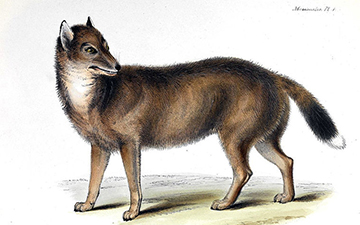The Falkland Islands wolf (Dusicyon australis), also known as the warrah and occasionally as the Falkland Islands dog, Falkland Islands fox or Antarctic wolf, was the only native land mammal of the Falkland Islands. This endemic canid became extinct in 1876, the first known canid to have gone extinct in historical times. It was the only modern species in the genus Dusicyon.
Traditionally it had been supposed that the most closely related genus was Lycalopex, including the culpeo, which has been introduced to theFalkland Islands in modern times. However, in 2009, a cladistic analysis of DNA identified the Falkland Island wolf’s closest living relative as the maned wolf (Chrysocyon brachyurus)—an unusually long-legged, fox-like South American canid, from which it separated about 6.7 million years ago.[3]
The Falkland Islands wolf existed on both West and East Falkland, but Charles Darwin was uncertain if they were differentiated varieties.[4] Its fur had a tawny colour. The tip of the tail was white. Its diet is unknown, but, due to the absence of native rodents on the Falklands, probably consisted of ground-nesting birds such as geese and penguins, grubs and insects, as well as seashore scavenging.[5] It has sometimes been said that it may have dwelt in burrows.[6]
The first recorded sighting was by Capt. John Strong in 1690.[7] Captain Strong took one of the animals on his ship, but during the voyage back to Europe the creature became frightened by the firing of the ship’s cannon and jumped overboard.[7][8] Louis Antoine de Bougainville, who established the first settlement in the Falkland Islands termed it a loup-renard (“fox–wolf“). The name “warrah” is a corruption of the term aguará (meaning “fox” in Guaraní, a Native American language), because of its similarity to the maned wolf (“aguará guazú”.) The warrah’s Latin name translates into “foolish dog of the south”, because of its apparent lack of fear of people.
When Charles Darwin visited the islands in 1833 he found the species present on both West and East Falkland, and tame. However, at the time of his visit the animal was already very rare on East Falkland, and even on West Falkland its numbers were declining rapidly. He predicted that the animal would join the dodo among the extinct within “a very few years.” It was hunted for its valuable fur, and the settlers, regarding the wolf as a threat to their sheep, poisoned it.[9] There were no forests for the animal to hide in, and it had no fear of man; it was possible to lure the animal with a chunk of meat held in one hand, and kill it with a knife or stick held in the other. However, it would defend itself occasionally if it needed to, as Admiral George Grey noted when they landed on West Falkland at Port Edgar on December 17, 1836:
I landed in the creek and had hardly put a foot on shore, when one of the foxes of the country was chased by Pilot. I ran up as they were fighting and came to the poor dog’s assistance who had nearly met his match, and a rifle ball soon settled the business, but the Pilot had received a terrible bite in the leg.
A live wolf was taken to London Zoo, England in 1868.[10] Another “Antarctic wolf” arrived in 1870. Neither animal survived long. Only a dozen or so museum specimens exist today.[3]
In 1880, after the animal became extinct, Thomas Huxley classified it as related to the coyote. In 1914, Oldfield Thomas moved it to the genusDusicyon, with the culpeo and other South American foxes. (These other canids have since been removed to Lycalopex.)
(From Wikipedia, October 2013)



